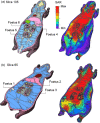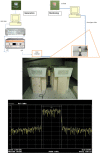Early-Life Exposure to Pulsed LTE Radiofrequency Fields Causes Persistent Changes in Activity and Behavior in C57BL/6 J Mice
- PMID: 31522469
- PMCID: PMC6790696
- DOI: 10.1002/bem.22217
Early-Life Exposure to Pulsed LTE Radiofrequency Fields Causes Persistent Changes in Activity and Behavior in C57BL/6 J Mice
Abstract
Despite much research, gaps remain in knowledge about the potential health effects of exposure to radiofrequency (RF) fields. This study investigated the effects of early-life exposure to pulsed long term evolution (LTE) 1,846 MHz downlink signals on innate mouse behavior. Animals were exposed for 30 min/day, 5 days/week at a whole-body average specific energy absorption rate (SAR) of 0.5 or 1 W/kg from late pregnancy (gestation day 13.5) to weaning (postnatal day 21). A behavioral tracking system measured locomotor, drinking, and feeding behavior in the home cage from 12 to 28 weeks of age. The exposure caused significant effects on both appetitive behaviors and activity of offspring that depended on the SAR. Compared with sham-exposed controls, exposure at 0.5 W/kg significantly decreased drinking frequency (P ≤ 0.000) and significantly decreased distance moved (P ≤ 0.001). In contrast, exposure at 1 W/kg significantly increased drinking frequency (P ≤ 0.001) and significantly increased moving duration (P ≤ 0.005). In the absence of other plausible explanations, it is concluded that repeated exposure to low-level RF fields in early life may have a persistent and long-term effect on adult behavior. Bioelectromagnetics. 2019;40:498-511. © 2019 The Authors. Bioelectromagnetics Published by Wiley Periodicals, Inc.
Keywords: activity; brain; electromagnetic fields; locomotion; rodent.
© 2019 The Authors. Bioelectromagnetics Published by Wiley Periodicals, Inc.
Figures







References
-
- Berman E, Carter HB, House D. 1984. Growth and development of mice offspring after irradiation in utero with 2,450‐MHz microwaves. Teratology 30:393–402. - PubMed
-
- Birks L, Guxens M, Papadopoulou E, Alexander J, Ballester F, Estarlich M, Gallastegi M, Ha M, Haugen M, Huss A, Kheifets L, Lim H, Olsen J, Santa‐Marina L, Sudan M, Vermeulen R, Vrijkotte T, Cardis E, Vrijheid M. 2017. Maternal cell phone use during pregnancy and child behavioral problems in five birth cohorts. Environ Int 104:122–131. - PMC - PubMed
-
- Department of Health . 2011. Mobile phones and base stations. This leaflet outlines some of the measures taken to address health concerns about mobile phone service. © Crown Copyright 2011.
-
- Divan HA, Kheifets L, Obel C, Olsen J. 2008. Prenatal and postnatal exposure to cell phone use and behavioral problems in children. Epidemiology 19:523–529. - PubMed
MeSH terms
Grants and funding
LinkOut - more resources
Full Text Sources
Miscellaneous

